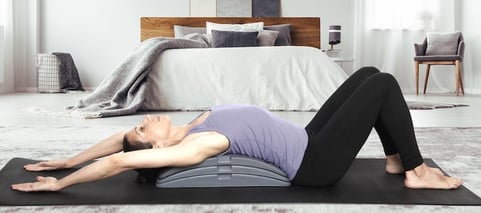Who do you think has more back pain and worse posture: The farmer, who spends his day plowing a field and shoveling manure, or the office worker, who works at a desk for eight hours a day? The answer - most likely, the office worker.
"Sitting Is The New Smoking."

Hunched over? Shoulders slumped? Head over-extended forward? It is no surprise. An estimated 54% of Americans with lower back pain spend the majority of their day sitting at a desk. I have mentioned the hot catchphrase that doctors everywhere are spouting: “Sitting is the new smoking.” Sitting exerts 30% more pressure on your spine than standing, so work that looks light and easy, is backbreaking. A sedentary lifestyle affects your bones, muscles, and organs and can even shorten your life.
Let’s focus on how siting can impact your back and posture -
- Neck - If you spend most of your day hunched at your desk, your neck is craned forward. If you are holding the phone between your shoulder and ear while you type, you are creating a dangerous imbalance. In the era of smartphones, most people look down as they scan their social profiles, surf the web, and text friends and family members, all of which can result in “text-neck” or “tech-neck.”
- Shoulders – Your bad posture overextends the shoulders forward, making them stiff and sore.
- Spine – Spines that sit too much become rigid and inflexible, putting you at risk for more injury even during a simple task, like bending down.
- Discs – The discs in your spine get squashed when you sit, and the collagen around all of your supporting tendons and ligaments begin to harden, which heightens your risk of herniated lumbar discs.
Tips to Correct Your Posture
I detail how I assess poor posture, and other structural, digestive, and emotional causes of back pain in my book, 3 Weeks To A Better Back. And, you can take a self-assessment here. Whether you are sitting in the office all day or looking for an at-home back pain treatment or posture correction device, I offer the following tips to improve your posture -
- Sit Properly at Your Computer – People are constantly looking at their phones and computers, which creates bad postural habits. However, with minimal adjustments, your back and neck will be thanking you later. Make sure your computer screen is aligned with the middle of your body and is at eye level when sitting upright. Also, check your chair height so your feet can touch the floor or a footrest. If possible, sit with your low and middle back supported/touching your chair and your chair at a slightly reclined angle to release pressure in the lower spine.
- Exercise Regularly – Go for a brisk walk, take a swim, or play a round of tennis to get more of your muscles working in a more significant way. Thirty minutes is all you need, breaking the time down into three equal parts: warm-up, training, and cool-down. A little exercise will go a long way.
- Stretch Your Back to Increase Flexibility - Having great flexibility means you’ll be able to stand up straighter, walk farther, and do more things with less pain. The Backbridge can be used in the office or for at-home back pain relief and posture correction. In as little as 4 minutes a day, you can have better posture with less forward hunch, which means less back pain. Though many stretches can help, one of my favorites is the Backbridge Extension -
- Get your Backbridge, choose the proper level (level 1 is the easiest and level 5 offers the largest stretch).
- Lie back so that the highest point of the Backbridge is between your shoulder blades and your head touches the floor.
- Rest your arms on the floor over your head and hold this stretch for 2 minutes (repeat twice a day, in the morning and evening).
- After a few weeks, slowly progress to the next level (2-5).

- Sleep – You can and should be promoting spinal health while you sleep. First, make sure you have a mattress and pillow that provides the right support but also conforms to the body, which is less stressful on the spine. Sleep with only one pillow under your head, and in the correct sleeping position.
- Do not cross your legs – When you sit, place both feet directly on the floor in front of you. If you sit with your legs crossed, your upper back will be complaining later during the day.
Poor posture not only puts more pressure on the back and causes back pain, but also can exude weak confidence. With these few simple tips, you can stand tall, confident, and without pain. Take back your posture, and give your back a break.

